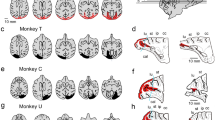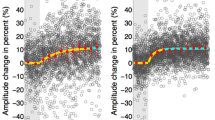Abstract
Functionally, saccadic eye movements are closely linked to visuo-spatial orientation. Anatomically, the network of cortical areas controlling saccades also seems to be involved in spatial attention and orientation. Consequently, lesions should cause deficits in both categories. We investigated this in 34 patients with focal unilateral lesions of the posterior parietal cortex (PPC), the frontal eye fields (FEF), the supplementary motor area (SMA), or the dorsolateral prefrontal cortex (PFC). Saccadic eye movements were recorded using infrared reflection oculography. Visual hemineglect or other visuo-spatial disorders were investigated by a series of standardized paper-pencil tests. Further, the internal spatial coordinates (subjective visual vertical and subjective straight ahead) were assessed psychophysically. Depending on the site of the lesion, different patterns of deficits were identified: lesions of the PPC impaired reflexive exploration of visual space in terms of delayed and hypometric visually triggered saccades into the contralesional hemifield, related to the severity of visual hemineglect. Further, PPC lesions specifically affected basic functions of the perceptual analysis of space, such as the internal spatial coordinates and spatial constancy across saccades. The latter was tested by applying visual double-step stimuli, where saccade-related extraretinal information had to be taken into account for achieving spatial accuracy. Frontal lesions left these functions intact. FEF lesions, however, impaired systematic intentional exploration of space, thus causing an exploratory-motor type of visual hemineglect. Prefrontal (PFC) lesions impaired the working memory for saccade-related spatial information, and SMA lesions affected temporal properties such as the timing of saccadic sequences, but did not cause specific visuo-spatial deficits. In conclusion, patients with frontal or parietal cortical lesions often exhibit combined saccadic and visuo-spatial disorders, most of which are topically specific.
Similar content being viewed by others
Author information
Authors and Affiliations
Rights and permissions
About this article
Cite this article
Heide, W., Kömpf, D. Combined deficits of saccades and visuo-spatial orientation after cortical lesions. Exp Brain Res 123, 164–171 (1998). https://doi.org/10.1007/s002210050558
Issue Date:
DOI: https://doi.org/10.1007/s002210050558




